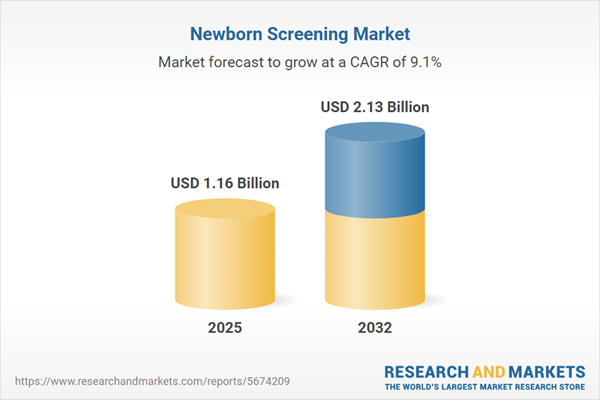Speak directly to the analyst to clarify any post sales queries you may have.
The newborn screening market is experiencing a period of robust evolution, driven by rapid technological advancements, broader clinical mandates, and a rapidly changing global regulatory environment. As early detection becomes increasingly prioritized across healthcare systems, industry leaders must navigate emerging opportunities and operational complexities to remain competitive in this high-impact sector.
Market Snapshot: Newborn Screening Market Size and Growth
The Newborn Screening Market grew from USD 1.06 billion in 2024 to USD 1.16 billion in 2025. It is expected to continue growing at a CAGR of 9.06%, reaching USD 2.13 billion by 2032.
Scope & Segmentation of the Newborn Screening Market
This report covers a comprehensive analysis of technology platforms, test types, end users, sample types, and regional markets:
- Technology Platforms: High-performance liquid chromatography, immunoassay systems, molecular techniques such as polymerase chain reaction and Sanger sequencing, next generation sequencing, tandem mass spectrometry
- Test Categories: Cystic fibrosis, endocrine disorders, hemoglobin disorders, inborn errors of metabolism
- End User Environments: Diagnostic laboratories, hospitals and clinics, research laboratories
- Sample Types: Dried blood spot, serum sample
- Regional Coverage: Americas (including North America: United States, Canada, Mexico; and Latin America: Brazil, Argentina, Chile, Colombia, Peru), Europe, Middle East & Africa (Europe including United Kingdom, Germany, France, Russia, Italy, Spain, Netherlands, Sweden, Poland, Switzerland; Middle East including United Arab Emirates, Saudi Arabia, Qatar, Turkey, Israel; Africa including South Africa, Nigeria, Egypt, Kenya), Asia-Pacific (China, India, Japan, Australia, South Korea, Indonesia, Thailand, Malaysia, Singapore, Taiwan)
- Company Coverage: PerkinElmer, Inc., Thermo Fisher Scientific Inc., Danaher Corporation, Agilent Technologies, Inc., Waters Corporation, Abbott Laboratories, Bio-Rad Laboratories, Inc., BioMérieux SA, Siemens Healthineers AG, Shimadzu Corporation
Key Takeaways for Senior Decision-Makers
- Emerging technologies are expanding screening panels, allowing early detection and intervention for a broader range of congenital and metabolic disorders.
- The adoption of high throughput methodologies increases operational efficiency, enabling laboratories to process and analyze greater sample volumes with minimal delay.
- Data-driven approaches using machine learning and digital health tools refine diagnosis, reduce false positives, and support personalized newborn care pathways.
- Collaborative initiatives between industry, governments, and healthcare sectors are driving global standardization and broader access, particularly in emerging markets.
- The flexibility to adapt workflows in response to changing policies and supply chain challenges is vital for operational resilience and long-term sustainability.
Tariff Impact on Supply Chain and Cost Structures
Recent United States tariff measures have impacted the newborn screening value chain by raising import duties on critical reagents and instruments, contributing to higher laboratory operating costs. Industry leaders have mitigated these pressures by diversifying supply sources, investing in process automation, and forming strategic alliances for tariff exemptions. These measures help ensure program continuity and maintain timely access to screening, especially for high-risk populations.
Methodology & Data Sources
This analysis is grounded in a rigorous framework combining expert interviews with clinicians, laboratory directors, and public health policymakers, as well as comprehensive secondary data from peer-reviewed research, regulatory filings, and clinical guidelines. Triangulation methods and validation workshops with domain experts ensure robust, credible insights.
Why This Report Matters
- Provides strategic intelligence to optimize technology adoption and resource allocation across diverse regional markets
- Offers actionable guidance on navigating regulatory shifts, supply chain disruptions, and evolving clinical protocols in the newborn screening sector
Conclusion
The newborn screening market is at a pivotal point, shaped by advances in diagnostics, policy shifts, and strengthened industry collaboration. Stakeholders equipped with this insight are best positioned to capitalize on growth opportunities and enhance patient outcomes.
Additional Product Information:
- Purchase of this report includes 1 year online access with quarterly updates.
- This report can be updated on request. Please contact our Customer Experience team using the Ask a Question widget on our website.
Table of Contents
3. Executive Summary
4. Market Overview
7. Cumulative Impact of Artificial Intelligence 2025
List of Figures
Samples

LOADING...
Companies Mentioned
The key companies profiled in this Newborn Screening market report include:- PerkinElmer, Inc.
- Thermo Fisher Scientific Inc.
- Danaher Corporation
- Agilent Technologies, Inc.
- Waters Corporation
- Abbott Laboratories
- Bio-Rad Laboratories, Inc.
- BioMérieux SA
- Siemens Healthineers AG
- Shimadzu Corporation
Table Information
| Report Attribute | Details |
|---|---|
| No. of Pages | 196 |
| Published | October 2025 |
| Forecast Period | 2025 - 2032 |
| Estimated Market Value ( USD | $ 1.16 Billion |
| Forecasted Market Value ( USD | $ 2.13 Billion |
| Compound Annual Growth Rate | 9.0% |
| Regions Covered | Global |
| No. of Companies Mentioned | 11 |









